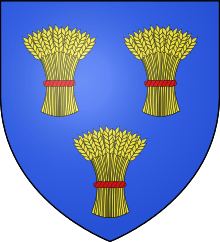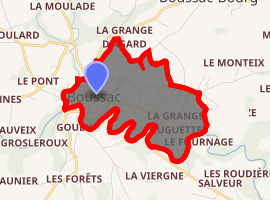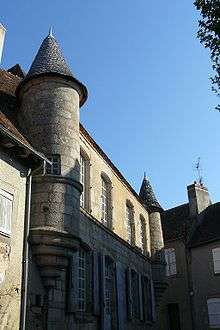Boussac, Creuse
Boussac is a commune in the Creuse department in the Nouvelle-Aquitaine region in central France. The famous Lady and the Unicorn Tapestries (c. 1500) were discovered in 1841 in Boussac castle. In 1844 the novelist George Sand saw them and brought public attention to the tapestries in her works at the time (most notably in her novel Jeanne), in which she correctly dated them to the end of the fifteenth century, using the ladies' costumes for reference. In 1863 they were bought by the Musée de Cluny in Paris where they are still on display.
Boussac | |
|---|---|
 Chateau | |
 Coat of arms | |
Location of Boussac 
| |
 Boussac  Boussac | |
| Coordinates: 46°20′59″N 2°12′56″E | |
| Country | France |
| Region | Nouvelle-Aquitaine |
| Department | Creuse |
| Arrondissement | Aubusson |
| Canton | Boussac |
| Intercommunality | CC Creuse Confluence |
| Government | |
| • Mayor (2020–2026) | Franck Foulon |
| Area 1 | 1.48 km2 (0.57 sq mi) |
| Population (2017-01-01)[1] | 1,257 |
| • Density | 850/km2 (2,200/sq mi) |
| Time zone | UTC+01:00 (CET) |
| • Summer (DST) | UTC+02:00 (CEST) |
| INSEE/Postal code | 23031 /23600 |
| Elevation | 335–395 m (1,099–1,296 ft) (avg. 384 m or 1,260 ft) |
| 1 French Land Register data, which excludes lakes, ponds, glaciers > 1 km2 (0.386 sq mi or 247 acres) and river estuaries. | |
Geography
A small light industrial town situated by the banks of the Petite Creuse river, some 25 miles (40 km) northeast of Guéret, at the junction of the D11 and the D997 roads.
Population
| Historical population | ||
|---|---|---|
| Year | Pop. | ±% |
| 1962 | 1,514 | — |
| 1968 | 1,557 | +2.8% |
| 1975 | 1,933 | +24.1% |
| 1982 | 1,852 | −4.2% |
| 1990 | 1,652 | −10.8% |
| 1999 | 1,602 | −3.0% |
| 2008 | 1,394 | −13.0% |
Personalities
- Jean de Brosse, Marshal of France, lived and died here
- Pierre Leroux (1797–1871), philosopher, friend of George Sand was mayor here in 1848
- George Sand (1804–1878), set her romance Jeanne here in 1836
Sights
- The church of St. Anne, dating from the fifteenth century
- The twelfth-century castle
- The remains of the old town ramparts
- Several ancient houses and the river bridge, all from the fifteenth century

Turreted house
See also
References
- "Populations légales 2017". INSEE. Retrieved 6 January 2020.
External links
- Official website of the commune (in French)
| Wikimedia Commons has media related to Boussac (Creuse). |
This article is issued from Wikipedia. The text is licensed under Creative Commons - Attribution - Sharealike. Additional terms may apply for the media files.